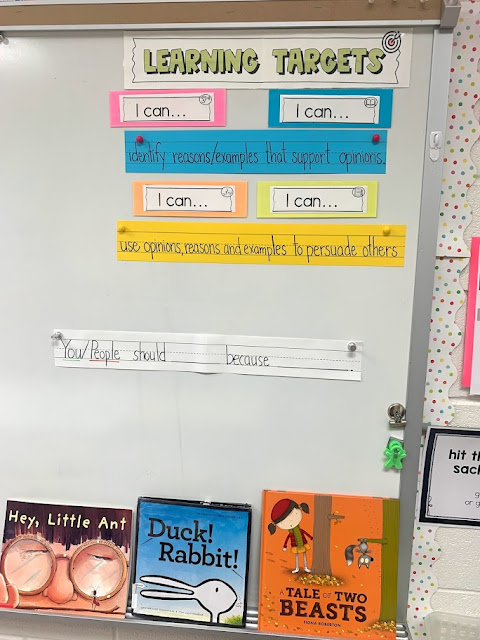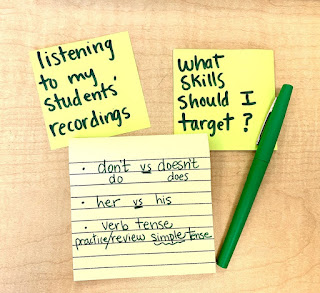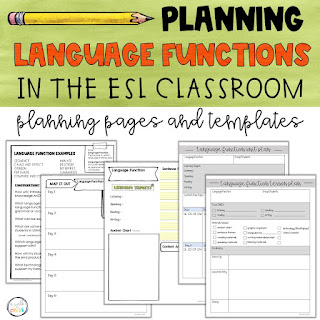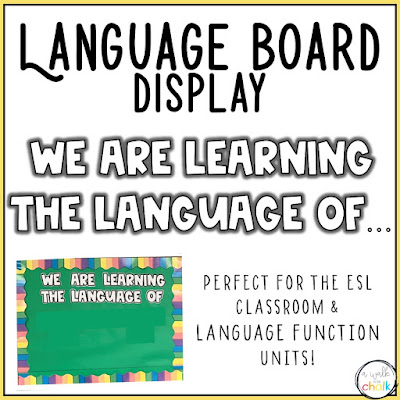What are language functions? LFs are the “reasons” we use language; it’s our purpose, or goal, when we express ourselves. Perhaps we want to express our needs or wants, explain a process, describe an experience, or persuade someone to do something. Whatever the purpose, we use language to perform these functions.
Examples of Language Functions:
-express wants/needs
-sequence
-compare/contrast
-opinion
-persuade
-inform
-describe
-analyze
-cause/effect
-summarize
-ask questions
Students use language functions in every grade level and across all content areas, so what better way to set English learners up for success than by explicitly teaching the academic language needed to successfully use language functions. Here is how this looks in my ESOL classroom.
Planning
I like to plan certain LF units during specific times of year. For example, Inquiry is my first unit because I want to teach students how to ask questions and clarifying questions to seek information. Compare/Contrast is fun in the fall due to apples and pumpkins. Cause/Effect is great in the winter because I like to use the topic of seasonal changes on plants and animals. Opinion/Persuade is great in the spring because I use the topic of plastic pollution, which ties into Earth Day. I sprinkle other LF units throughout the year, but those three I pretty much keep at the same time each year. You could teach any LF at any time of the year; it’s very flexible. Each unit, in my classroom, lasts about 3-4 weeks, but again, it’s flexible.
Which language functions will my students need in order to be successful with the grade level content? When I sit down to plan a unit, I brainstorm science and social studies topics that my students will be learning about during year, then I pick the LF and topic I want to focus on. When we connect LF units with the content our students are, or will be, learning in their general education classrooms, it gives students the language tools and confidence they need to participate and succeed.
 |
| Language Functions Planning Process |
This is the tool I use to plan out my language function units. It helps me map out the BIG picture first, then hone in on the details. The main components of my planning are:
1- identify the language function
2- identify content areas topics
3- create learning targets
4- locate activities to support the four language domains
5- determine the scaffolds needed
Learning Targets
I like to backwards plan by first identifying what I want my students to be able to do by the end of each LF unit. This becomes the learning target(s) for the unit. I have targets for both expressive (speaking and writing) and interpretive (listening and reading) language. A focus on the verb is important because it’s what we want students to do, for example: identify, use, label, illustrate, explain, etc. The learning targets are then posted and referenced throughout each unit.
Activities
Once I’ve identified the learning targets, I start collecting activities and resources at various proficiency levels to practice viewing, listening, reading, speaking and writing skills. I also think about how I’ll build background knowledge for the topic. I love to incorporate videos, so YouTube, BrainPOP Jr. and EPIC Books are places I typically go to first for engaging video resources. Building background knowledge using a short video is highly effective, IMO. It’s an engaging way to get students talking about what they already know or think about a topic.
This planning phase is all about finding materials that will help facilitate the language function. Since I work with a wide variety of proficiency and grade levels, I need a variety of resources. Here are some of my favorites for the 4 language domains.
Listening
I primarily use videos for this domain. I tell my students what to listen for and will stop the video in designated places to give them time to process and respond. Again, my top 3 places to find videos in order of preference are YouTube, BrainPOP Jr (paid subscription) and EPIC Books. EPIC has some really great videos, and it’s a free resource! ReadWorks.org is another great site. The reading passages there have an audio component, so it’s not a video, but it’s an article read aloud. You could create your own questions for the article, but comprehension question are already provided for each passage. Nice!
Reading
For reading materials I look through my school’s bookroom first. Then I check out Reading A-Z (a subscription my school pays for), Readworks.org, EPIC books (both are free), another online subscription resource from Benchmark Education, and lastly my own collection of books.
 |
| Reading Materials for Cause and Effect |
The picture above shows some of the reading materials I gathered for my cause and effect unit. I searched for resources that demonstrated how changes in climate or weather impact plants and animals.
 |
| Reading Materials for Opinion/Persuade |
As you can see, I’m a “spreader outer.” By spreading out all of my resources during this planning phase, I can quickly see what I have and what I still need.
Speaking
I want my students talking everyday, so we do a variety of speaking activities in my ELD groups. This is probably the number one reason why I love the pull-out model of instruction, but that’s a blog post for another day. Some activities I use are talking mats, games, class discussions, partner talks and simply sharing our thinking. Oral language is the foundation of language and literacy so I’m intentional about providing structured (and unstructured) opportunities for students to use oral language each time we meet.
 |
| Talking Mat Activity for Cause and Effect |
 |
| Students chose the cards they wanted to talk about, then used the sentence frame as needed. |
One of my favorite speaking activities is having students record a Flipgrid video. They always moan about it at first, but then they get into it and enjoy watching and responding to their classmates’ videos. It’s also a great way to measure progress. You have recorded examples of your students speaking throughout the year! I like to jot down notes while I listen (and re-listen) to their recordings. This helps me target certain areas that my students need additional practice with, then I create or find mini-lessons for those skills.
Writing
Writing is integrated with listening and reading activities. Students generally have something to respond to each time we meet. (They usually write inside their ELD notebooks.) Similar to speaking, I’ll have students writing at each meeting, even if it’s a short task. I frequently use graphic organizers for writing responses. I like to reduce the size of the graphic organizer to about 75% and trim the edges, then I’ll have students glue it into their notebooks.
At the end of each LF unit, there is a written or oral language component, sometimes both. It’s an assessment to demonstrate their ability to apply the language function. Usually it’s a prompt written in their ELD notebooks, but it could also be a digital activity. This past spring, at the end of our Opinion/Persuade unit, students had the choice to either create and present a Google Slide presentation, record a Canva video, or create a poster.
Scaffolds
Let’s talk scaffolding for a moment. This is where we consider the specific language needs of our students and the appropriate supports for them. Scaffolds will vary from group to group. Some groups/students will need sentence frames, while others may only need sentence stems. Some groups will need more modeling than others. Some will need more visuals. Some will need extra opportunities to practice. Some might need L1 support. All will need explicit vocabulary instruction. We want to challenge our students without frustrating them, so picking appropriate scaffolding is key.
Language Function Unit in Action
For each unit, I display a “language board.” It’s a jumping off point and a reference tool that provides what the language function is, gives an example, along with key words.
Next, I build some background knowledge so that students can connect to the reason we use the LF. It could be as simple as asking, “What do you already know about…”
Then we dive into the plans and activities for listening, reading, speaking and writing skills. They spend the next 10-15 days practicing and using the language for the language function.
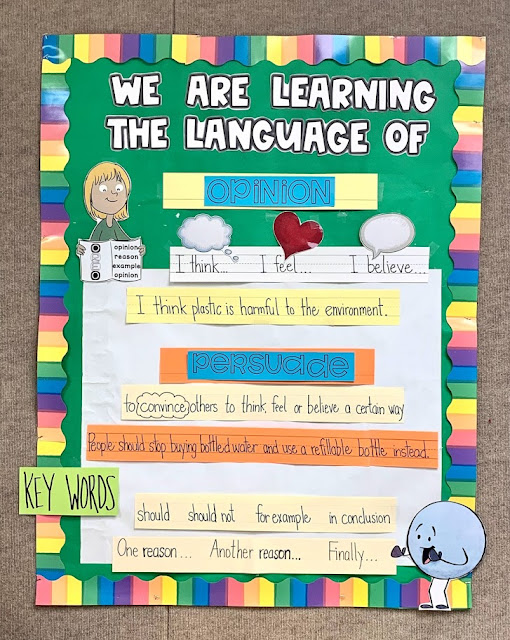 |
| Language Function Board for Opinion & Persuade |
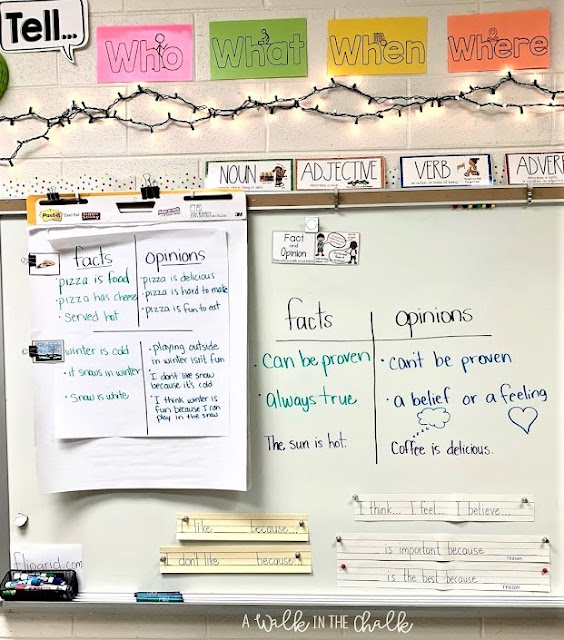 |
| Introductory Lesson for Opinion/Persuade |
 |
| Model OREO Opinion Writing |
 |
| Opinion Lesson – real life example to connect students’ experiences with learning target |
 |
| Reading Activity- Will students’ opinions about plastic bags change? |
 |
| Intermediate ELD group- students gave their opinion about plastic bags prior to reading. |
In Closing
The best part about incorporating language functions into my ESL classroom is that ALL of my ELD groups are learning the same language function. This makes planning so much more manageable. Instead of planning 10 different lessons for ten different groups, all of my groups are learning the language of persuade at their language level. I love it! And more importantly, my students love it too! These units are fun, engaging, flexible and highly effective at building academic language.
Do you teach language functions? If so, do you have a favorite?
To learn more, check out my next post on incorporating Language Forms with Functions! 🙌

